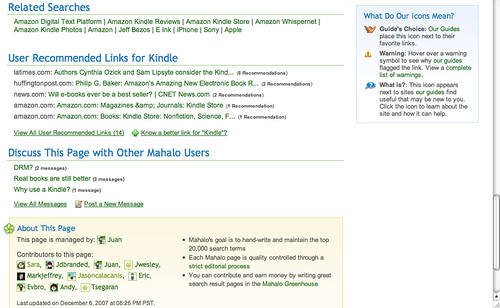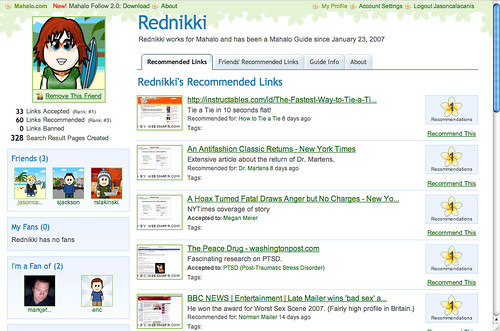Mahalo Adds The Social Graph To Search
Everyone’s been talking about how the social graph is the next evolution of search. Search 4.0. The next step forward after Search 3.0’s blended and personalized search. Today, Mahalo is taking that next step and adding a social layer to their search results. Jason Calacanis, Mahalo founder, says that the problem of search will be […]
Everyone’s been talking about how the social graph is the next evolution of search. Search 4.0. The next step forward after Search 3.0’s blended and personalized search. Today, Mahalo is taking that next step and adding a social layer to their search results. Jason Calacanis, Mahalo founder, says that the problem of search will be solved by a combination of machines, human curation, and social interaction, and with today’s launch of Mahalo Social, Mahalo adds the beginning of that elusive social interaction. The new features include profiles and the ability to recommend links for search terms. Much like Digg or Delicious, users can add friends and see what those friends are recommending. Below, more information on how Mahalo plans to deal with spam, work with webmasters, and if this approach will scale.
Jason acknowledges that Mahalo is a content site rather than a search engine. 30% of the site is editorially generated by their staff, but it’s presented in a search context. Mahalo contains about 26,000 pages so far and Jason says they’ll never cover the long tail of search. But he does think they’ll catch up with the amount of content on Wikipedia, and within five years should be covering up to half of what people are searching for. (Don’t worry Jason, it’s mostly Britney Spears and sex. And I see you’ve got those two subjects covered.)
Mahalo employs 60 full-time editors, 400 paid contributors, and 3,000 “Greenhouse” volunteers. This enables them to add around 1,000 new pages a week, but they need a way to find more quality links and gain more insight into what people want pages about. So, they’re now handing Tom Sawyer-like paint brushes out to the rest of us and looking to crowdsourcing to help paint the search results fence. Harnessing the wisdom (or lack thereof, as the case may be) of crowds helps them overcome what they feel is currently their greatest hurdle: adding and updating pages.
Anyone can now create a profile on Mahalo, then start recommending links for search terms (regardless of whether those terms have existing Mahalo pages). You can submit using either the Mahalo toolbar or directly from the site.
How will Mahalo combat spam? Each link will be reviewed before it’s accepted. You can see your accepted/rejected stats on your profile page. Accepted links appear in the “user recommended links” section of the search page, and anyone who contributes links will be listed in the “contributors to this page” section.
Mahalo won’t use a Digg-like system to enable people to vote on links. Jason says he’s looking for quality over quantity and doesn’t want users to simply skim a list of headlines and vote for what catches their attention. Instead, votes accumulate based on multiple recommendations.
All recommendations go to human editors, who either approve them, wait for further recommendations, or ban them. Is this scalable? Jason says he doesn’t expect a lot of participation (he cited the fact that most user-generated content tends to come from a small fraction of a community, and he expects Mahalo to be no different) and claims he’ll be happy with 50 people participating in the first month, with a few thousand by the first year.
However, he is looking at ways to scale this a bit, just in case he gets a few more than 50 signing up. For instance, they may implement a kind of “PeopleRank” that trusts those who have a large number of accepted submissions more. Over time, those with high PeopleRank may have their recommendations added immediately with after-the-fact review.
Jason doesn’t expect to use this model to build new search pages, but he does think it can improve quality and freshness of existing pages by around 20%. After all, he says, it takes 30 seconds to review an incoming link vs. the 10-20 minutes it would take to find it.
He is being very clear that he’s not competing with social networking sites like Facebook or MySpace. He points out that social networking can be either a standalone product (such as those sites) or it can be something that simply enhances an unrelated product (like Mahalo). He’s interested in the latter. He says Mahalo will have no donut throwing, zombies, or scrabble games. The social networking component, is, in fact, a bit bare. You can create a profile, become a fan of someone (when that person reciprocates, you become a friend), and see the recommendations of your friends and those you are a fan of. There’s no messaging feature, although it sounds like that may be coming. Each search result page does have a discussion board that has been made more visible and enables you to discuss the topic with others and Mahalo editors.
Jason points to this discussion forum as one way Mahalo is responsive to site owners. The major search engines are too large to scalably handle each webmaster’s concerns. But Mahalo can respond to individual questions, such as explain why a particular site didn’t make the cut on a page.
Why should you create a Mahalo profile and start recommending links? I suppose that question could be asked of sites like Digg and StumbleUpon also. Fame and recognition are certainly draws. If you’re a webmaster, you may want to get your own site’s pages in front of Mahalo editors. (In that way, this new recommendation system is more like a DMOZ submission than social networking.) Jason has left the door open for the possibility of payment or prizes for top submitters as well.
Will this improve Mahalo search results? Well, they’re not really, strictly speaking, search results. They’re hand-crafted content, and certainly more people recommending links could improve comprehensiveness and freshness. That could also make things cluttered, and reviewing recommendations could overtake the time of editors who might otherwise be creating more pages. The idea of layering social behavior on top of search could be the key to that next step of search, and while this implementation may not be that key, it’s an interesting foray into the possibility. Better would be taking advantage of user behavior that didn’t exist solely in the vacuum of improving the search experience. For instance, Yahoo! could take advantage of the behavior of Delicious users and add what they are sharing, bookmarking, and tagging as signals in their search results. And of course, using social networking data for search has been tried before. Eurekster comes to mind.
On the other hand, at yesterday’s Search 2010 webinar, held by Enquiro Research, all of the major search engines felt that the intersection of the social graph with search was valuable, but was challenging enough that tackling it was still a ways off. Marissa Mayer commented that searchers want their history to be private and manual tagging is just too difficult. Jakob Nielson felt that social networks are still too small to make an impact on something as large as search. To give Yahoo! some credit, they did point out that they are investing in social media products and are very interested in this intersection, although it sounded like their initial work will be in personalization, rather than in radically changed overall search results. But overall (despite the promise of OpenSocial), I didn’t get the sense that the major search engines are actively working on integrating the social graph with search in the way that Mahalo seems eager to do.
Mahalo is announcing a few other changes today as well. They are changing the restrictions on their content from all rights reserved to a limited creative commons license and making all content available via RSS.
Those who want to subscribe to updates or do mashups can use the OPML file to slice and dice however they choose (within the licensing guidelines).
Contributing authors are invited to create content for Search Engine Land and are chosen for their expertise and contribution to the search community. Our contributors work under the oversight of the editorial staff and contributions are checked for quality and relevance to our readers. The opinions they express are their own.
Related stories
New on Search Engine Land




